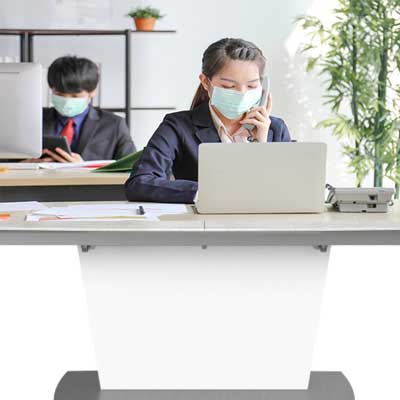Return to Work after Covid-19 – Checklist from HR | Aparna Sharma | Senior HR Professional & Certified Corporate Director I Editor’s Collection
 As employers attempt to return to workplaces in the midst of & after the COVID-19 pandemic, there are a number of considerations they must be mindful of. Indeed, among other things, employers must be sure to establish a COVID-19 response plan, refine their communications and policies, examine travel policies, and ensure compliance with various central & state laws.
As employers attempt to return to workplaces in the midst of & after the COVID-19 pandemic, there are a number of considerations they must be mindful of. Indeed, among other things, employers must be sure to establish a COVID-19 response plan, refine their communications and policies, examine travel policies, and ensure compliance with various central & state laws.
Below is a checklist of issues employers should be mindful of & HR has a critical role to play in this.
- Stay Informed
 ● Continue to monitor the Central & State announcements with respect to change in legislations & for insights relative to navigating COVID-19 issues for employers.
● Continue to monitor the Central & State announcements with respect to change in legislations & for insights relative to navigating COVID-19 issues for employers.
● Learn of COVID-19 plans in the community where your business operates. Local conditions may have a significant impact on your business operations.
● Continue to stay informed relative to school and public transportation disruptions, which may affect business operations.
- Create and Implement a Response and Communication Plan
● Identify a team of individuals and a point of contact for the response plan. Be sure to involve key decision-makers and managers.
● Ensure flexibility—be ready to modify or amend business practices as needed.
● Where possible, prioritize customers, identify alternative suppliers, and determine where it may be appropriate to reduce operations.
● Prepare a plan of communication to employees that addresses:
▸ Teleworking policies and staggered schedules, which may be effective at increasing the physical distance among employees.
▸ Employee anxiety and misinformation.
▸ Point of contact from Management & HR for any help or information.
- Create and Implement a Safety Plan
● Consider where, when, and how employees may be exposed (such as from the public or other co-workers).
● Consider employees’ individual risk factors.
● Follow governmental regulations.
● Consider limitations on non-essential travel.
● Communicate basic prevention measures, consistent with governmental guidelines.
● Promote hand hygiene—frequent handwashing for all employees, visitors, and customers.
● Provide soap and water (or hand sanitizer with at least 60% alcohol) where possible.
● Encourage respiratory etiquette, including covering coughs and sneezes.
● Provide tissues and trash bins.
● Consider employee screening, including temperature checks and symptom questionnaires.
● Develop policies for identification and isolation of sick or exposed employees.
● Encourage employees to self-monitor for signs and symptoms of COVID-19.
● Ask employees who have been exposed to COVID-19 or travelled to a high-risk location to work from home for an incubation period of 14 days.
● Develop clear policies for reporting to HR/Management when an employee becomes sick or begins experiencing symptoms.
● Implement engineering controls such as high-efficiency air filters or sneeze guards where appropriate.
● Ensure the use of personal protective equipment (PPE) where appropriate, including face masks, respiratory protection, goggles, gloves, and face shields.
● Consider ensuring that the plan has general applicability to cover other infectious diseases.
- Consider Leave Options
● Review existing policies to ensure consistency with central & state rules as part of Disaster Management Act, 2005 (DM Act).
● Track employees’ use of leave, reason for leave, and duration.
● Ensure that individuals on leave return to their prior positions.
- Consider Confidentiality
● Require employees infected with COVID-19 to identify all individuals who have worked in close proximity.
● Inform other employees of any possible exposure, but keep the identity of infected employees confidential.
● Consider non-invasive screenings for employees, including body temperature checks and symptom questionnaires when entering the workplace. Maintain confidentiality in a manner such that:
(1) Results are kept separate from personnel file.
(2) Temperature results are kept confidential.
(3) You may disclose the name of an employee that has tested positive for COVID-19 to the respective state government authority.
- Consider Workers’ Compensation Issues
The law remains unsettled relative to workers’ compensation and COVID-19.It is advisable to remain abreast of developments.
There are questions as to whether COVID-19 will be considered an “ordinary disease of life,” which generally will not be covered.
Consider the workers’ compensation factors relative to COVID-19:
● Will the employee be able to demonstrate that he or she contracted the virus during the “course of their employment”
● Will the employee be able to demonstrate whether the contraction “arose out of” their employment.
● Did the position present the employee with an “increased risk” of contracting COVID-19?
- Remain Cognizant of Anti-Discrimination/Anti-Harassment Policies
● Consider redistributing anti-discrimination and anti-harassment policies, including POSH.
● Consider training for supervisory staff relative to responding to comments about COVID-19 and employees who may have been affected.
- Remote work
Telecommuting may have proven to work well during the pandemic for some employers and employees. Using it not only as a short term emergency tool to survive the next year but also as a permanent work/life balance and cost-saving measure should be considered.
Actions to consider include:
● Continuing to allow remote work where possible to keep employees safe.
● Staggering weeks in office and at home among team members, or part-time remote work on alternate weekdays.
● Responding to employee requests to continue to work from home, including long-term arrangements.
● Updating technology to support virtual workers.
● Consider the long-term cost savings or impact of offering permanent remote work.
- Policy changes
It is no longer business as usual, and employers will likely need to update or create policies to reflect the new normal. Some examples include:
● Paid-leave policies adjusted to reflect regulatory requirements and actual business needs.
● Attendance policies relaxed to encourage sick employees to stay home.
● Time-off request procedures clarified to indicate when time off can be required by the employer, should sick employees need to be sent home.
● Flexible scheduling options implemented allowing for compressed workweeks.
● Meal and rest break policies adjusted to stagger times and processes implemented to encourage physical distancing.
● Travel policies updated to reflect essential versus nonessential travel and the impact of domestic or global travel restrictions.
● Telecommuting policies detailed to reflect the type of work that is able to be done remotely and the procedures for requesting telework.
● Information technology policies revised to reflect remote work hardware, software and support.
- Unions
 Employers with unionized workforces may have additional considerations, including:
Employers with unionized workforces may have additional considerations, including:
● Determining obligations to bargain when implementing changes to mandatory bargaining subjects such as wages and benefits.
● Identifying the need to add a force majeure clause into a collective bargaining agreement to protect the employer from contractual obligations during an event that is beyond the employer’s control.
Reviewing existing no-strike clauses to ensure continued work during future infectious disease outbreaks.


